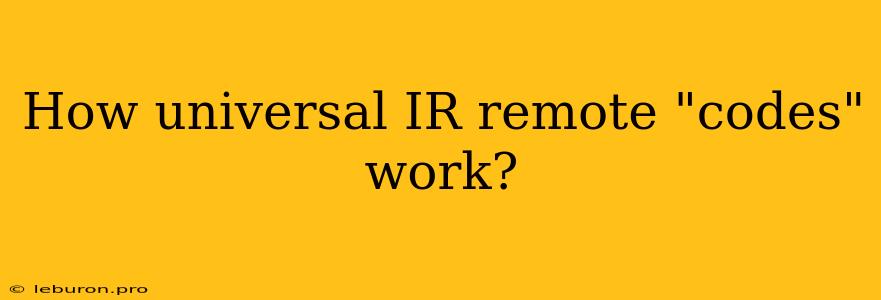Universal remote controls offer a convenient way to control multiple devices with a single remote, eliminating the clutter of individual remotes. But how do these remotes work, and how do they manage to communicate with different devices using seemingly universal "codes"? The answer lies in a combination of infrared technology, device-specific codes, and a learning process that allows the universal remote to understand and replicate the signals of various devices.
Understanding Infrared Technology
At the core of every universal remote is infrared (IR) technology. IR signals are invisible light waves that are emitted from the remote control and received by the device. The remote transmits a series of pulses of infrared light, each representing a specific command, such as power on, volume up, channel change, or playback control. The device, equipped with an IR receiver, detects these pulses and translates them into instructions for the device's internal workings.
The Importance of Frequency
While all IR remotes use infrared light, the specific frequency of the light emitted varies depending on the device. Typically, most devices operate within a narrow frequency band, ensuring proper communication between the remote and the device. This frequency plays a crucial role in ensuring the signal is received and interpreted correctly.
Device-Specific Codes and Libraries
The key to a universal remote's ability to control multiple devices lies in its internal library of device-specific codes. Every device manufacturer uses unique codes to represent different commands. These codes are essentially a series of "bits" – ones and zeros – that the remote transmits to the device.
Learning Mode and Code Matching
To operate a specific device, the universal remote needs to learn its unique code library. This is where the "learning mode" comes into play. In this mode, the user points the universal remote at the original device's remote and presses a button on the universal remote that they want to program. The universal remote then captures the IR signal emitted by the original remote and stores the corresponding code in its internal memory. This process is repeated for each button on the original remote that the user wants to program on the universal remote.
The Role of Code Libraries
Universal remote manufacturers maintain vast libraries of device codes, constantly updating them to include new devices and models. These libraries are often stored on the remote itself or accessible through online databases.
Programming with Pre-Set Codes
Many universal remotes come pre-programmed with a selection of common device codes. Users can often find their device's manufacturer and model in the remote's manual or online and then select the corresponding code. The remote will then attempt to communicate with the device using this pre-programmed code.
Limitations of Universal Remotes
Despite their versatility, universal remotes have limitations:
Compatibility Issues
Not all devices are compatible with all universal remotes. Some older devices or specialized equipment may not use standard IR communication protocols, making it challenging to control them with a universal remote.
Learning Mode Limitations
Some devices, such as older TVs or DVD players, may not emit a clear enough signal for the universal remote to learn their codes effectively. This can make it difficult to program certain buttons.
Limited Functionality
Even with successful programming, a universal remote might not support all the functions of the original device's remote. Some advanced features, such as specific menu options or custom settings, might not be accessible through the universal remote.
Conclusion
Universal remotes have revolutionized the way we control our electronic devices, offering convenience and simplification. The combination of infrared technology, device-specific codes, and learning capabilities makes it possible for a single remote to control multiple devices. However, it's important to remember that limitations do exist, and some devices may not be compatible with all universal remotes. Despite these limitations, universal remotes continue to provide a user-friendly and effective way to control our electronic world.
